The Battle Cry of Peace
Posted By Norman Gasbarro on April 10, 2012
In 1915, the Vitagraph Corporation released a silent film entitled “The Battle Cry of Peace.” The film played in theaters throughout the country, including Harrisburg, Dauphin County, Pennsylvania. This film’s direct connection with Abraham Lincoln and the Lincoln assassination is justification for a series of posts on this blog about one of it actors, William J. Ferguson. Ferguson was the actor in Our American Cousin who was claimed he was standing next to Laura Keene at the moment the fatal shot was fired by John Wilkes Booth. The posts begin today and continue through the rest of the week.
“The Battle Cry of Peace“
Propaganda Picture Produced by the Vitagraph Company Under the Personal Supervision of J. Stuart Blackton and Albert E. Smith. Written by J. Stuart Blackton and Directed by Wilfred North. In Nine Reels….
[Cast List includes William Ferguson as Abraham Lincoln].
“The Battle Cry of Peace” presents the motion picture’s most ambitious effort in the furtherance of propaganda. It comes to grips with the most pressing topic of the moment, the gospel of national preparedness, and, it would seem to the reviewer, drives its lesson well home. There can be little doubt but what “The Battle Cry of Peace” will play an important part in the agitation to strengthen our military effectiveness; that it will be able to lay claim to no small portion of whatever success the propaganda may meet. (from FultonHistory.com).
Potential film-goers in the Harrisburg, Dauphin County, area were introduced to the film by the following article and picture which appeared in The Patriot:
Only Living Man Who Saw Lincoln Assassinated Plays Abraham Lincoln in “The Battle Cry of Peace”
W. J. Ferguson in the Character of Lincoln
William J. Ferguson, the only man living who was on the stage of Ford’s Theatre in Washington on the evening of the assassination of Abraham Lincoln is appearing as the “Great Emancipator: in J. Stuart Blackton’s “The Battle Cry of Peace,” the patriotic spectacle advertising preparedness against war, playing all next week at the Orpheum except Thursday. (from The Patriot, 3 March 1916).
The Patriot ran an advertisement for the film prior to the completion of its run in Harrisburg:
“The Battle Cry of Peace”
“The Battle Cry of Peace,” which is being shown at the Orpheum Theater this week, is intended to show what might happen if a hostile nation were to invade our country when it is not prepared for war. The film is founded on Hudson Maxim‘s book “Defenseless America” and deals with plain, cold facts, but there is little story running throughout the picture which serves as a foundation for presenting facts which otherwise might become tiresome. While there are parts in “The Battle Cry of Peace” which might be said to be gruesome, yet they are relieved by little touches of humor. Some of the most notable stars in the film world today which are seen in “The Battle Cry of Peace” are Norma Talmadge, Charles Richman, W. J. Ferguson, Louise Beaudet, Mary Maurice, James Morrison and others. A special orchestra renders appropriate music for the picture. (from The Patriot, 9 March 1916).
During the showing of The Battle Cry of Peace, an advertisement in The Patriot praised the film and noted the presence of William J. Ferguson in the cast:
“The Battle Cry of Peace”
Those who have witnessed “The Battle Cry of Peace” at the Orpheum this week declare it to be one of the finest pictures ever shown. The story is so well told and so well acted that it cannot fail to make a deep and lasting impression. The theme of the story is “preparedness” and shows the horrors of war as it would be waged against us were a hostile nation to invade our country in its present defenseless condition. The picture cost $500,000 to produce and presents some of the best known stars in the moving picture world today. W. J. Ferguson, who appears as Abraham Lincoln in “The Battle Cry of Peace” is the only man, living who was on the stage at Ford’s Theatre in Washington the night Lincoln was assassinated.
Special music is furnished by an augmented orchestra. (from The Patriot, 10 March 1916).
In Philadelphia, the Lyceum also showed the picture for one week:
The cast members of The Battle Cry of Peace were featured in articles that appeared in local newspapers throughout the country with a picture-montage of many of the stars. William J. Ferguson was on the top line of pictures to the right of the producer Blackton:
An enlargement of the portrait of Ferguson from the above “poster”:
Ferguson’s portrayal of Abraham Lincoln was an important part of a flashback sequence, that although brief, tied Lincoln’s historic response to the Civil War to a lesson in preparedness that the film producers believed had to be followed for a war, then in Europe, that threatened to involve America.
In The Battle Cry of Peace, New York City was bombarded with an aerial attack and invaded. The film did not give the identity of the invaders, but they had an uncanny resemblance to the popular negative characterizations of Germans that were in used in the media at the time.
The filmmaker also went to great expense to show the destruction he believed would occur if the nation was unprepared:
— In order to make certain the realism of the scenes of carnage in “The Battle Cry of Peace,” the Vitagraph Company destroyed $30,000 worth of frame, brick and stone buildings, accomplishing this by actual bombardments in which real cannon and real shells of the largest calibre were used. When you see building after building toppled over on the screen at the Metropolitan Opera House, you see the picture of real devastation wrought in deadly earnest and the effect is marvelous. (from Philadelphia Inquirer, 21 Nov 1915).
After the United States entered the war in 1917, a scene from the film was reproduced on a poster calling for the purchase of Liberty Bonds. This poster depicted an attack on New York City, with a beheaded Statue of Liberty and an aerial bombardment.
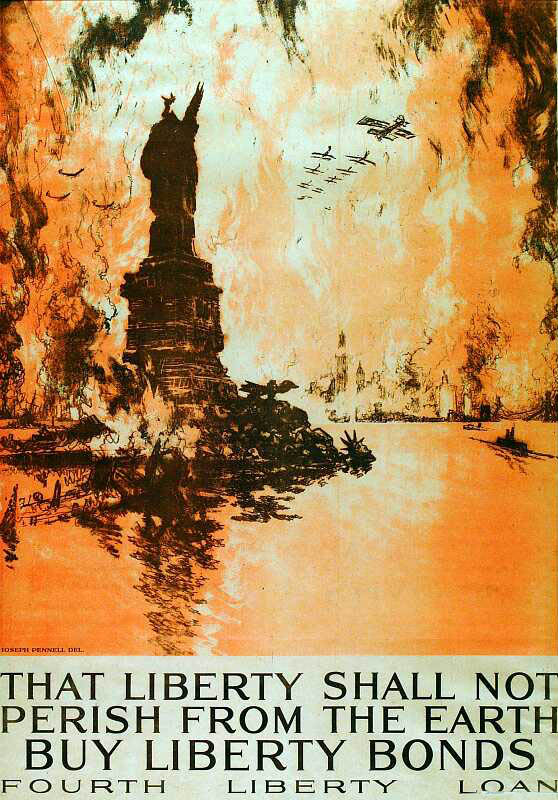 Robert Pennell poster for Liberty Loan, World War I.
Robert Pennell poster for Liberty Loan, World War I.
Unfortunately, there are no complete copies of The Battle Cry of Peace that exist today. Some portions or clips of the film have been found though none with Ferguson’s portrayal of Lincoln. Therefore, there is no way of knowing the level of realism given by Ferguson to the role, he being one of only a few living people who would have actually seen Lincoln, let alone portray him on the stage or in film.
In 1915, the 50th Anniversary of the Lincoln assassination was being observed. In the advertising of the film, “The Battle Cry of Peace,” Ferguson’s eyewitness to the assassination was nearly always noted. This gave William J. Ferguson a national audience to tell his story – the story of what he believed really happened the night of 14 April 1865. That story begins in tomorrow’s post.
The poster at the top of this post can be found on the blog Propaganda and Mass Persuasion which includes as discussion of the propaganda value of “The Battle Cry of Peace.” The Liberty Bond poster can be found in various forms via search of web images, including versions available at the National Archives. News articles and film advertisements are from the on-line resources of the Free Library of Philadelphia.
For previous blog articles on the Lincoln Assassination, click here.
 ;
;
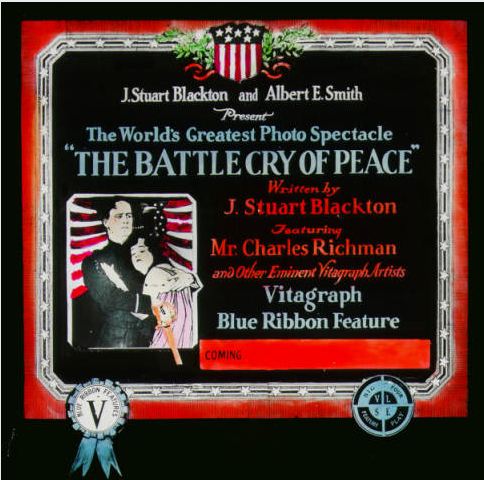

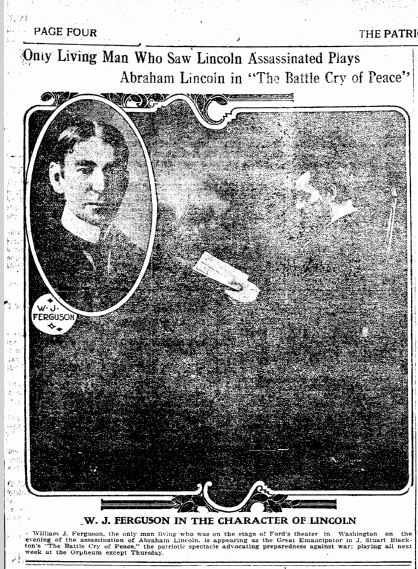

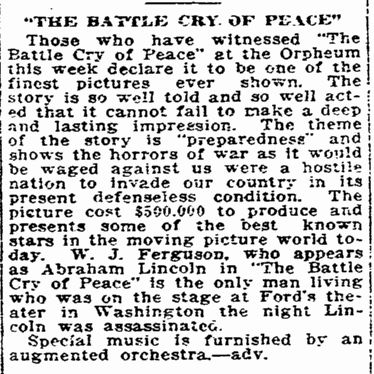

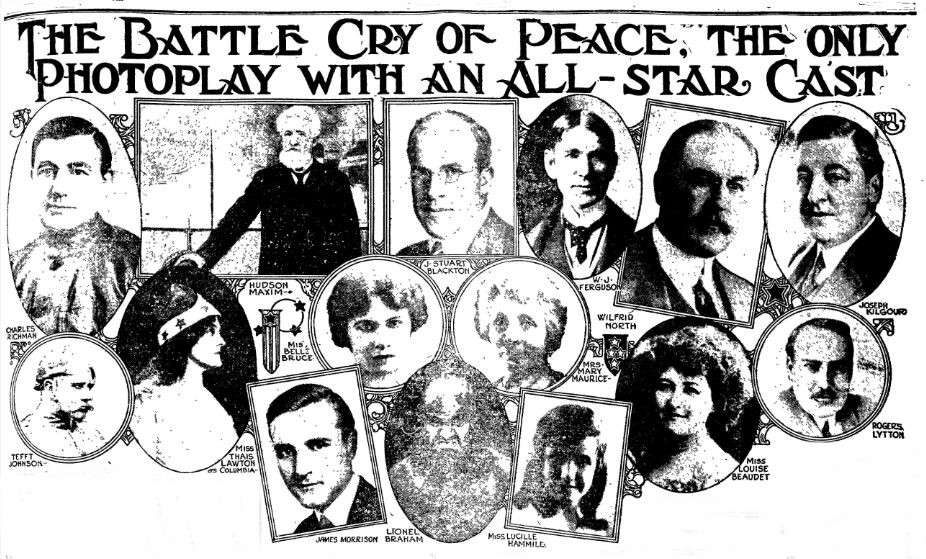

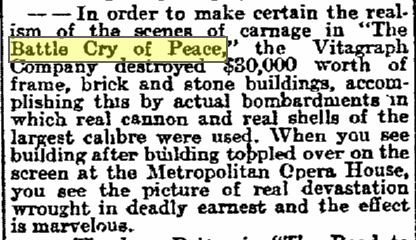


Comments